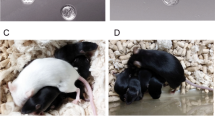Abstract
Purpose
Does thawing cleavage embryos and culturing them for transfer as blastocysts improve pregnancy and perinatal outcomes compared to transferring thawed blastocysts?
Methods
Retrospective, observational cohort study performed at two assisted reproductive technology centers, 2014 to 2020. A total of 450 patients with 463 thawed embryo transfer cycles were divided into 2 groups according to the embryonic developmental stage at cryopreservation and transfer: 231 thawed blastocysts (day 5 group) and 232 thawed cleavage embryos that were cultured for 2 days and transferred as blastocysts (day 3–5 group). The two groups were compared for demographics, routine parameters of IVF treatment, pregnancy rates, and perinatal outcomes.
Results
Multivariable logistic regression analysis for ongoing pregnancy and delivery demonstrated that the day 3–5 group had a greater likelihood of achieving ongoing pregnancy and delivery compared to the day 5 group (OR 1.58, 95%CI 1.062–2.361, p = 0.024). Perinatal outcomes were comparable between the three groups.
Conclusion
Our results support culturing post-thaw cleavage embryos for 2 days and transferring them as blastocysts to increase chances of ongoing pregnancy and delivery.
Similar content being viewed by others
Data availability
Data are available on request from the corresponding author.
Code availability
Not applicable.
References
Nagy ZP, Shapiro D, Chang CC. Vitrification of the human embryo: a more efficient and safer in vitro fertilization treatment. Fertil Steril. 2020;113:241–7.
Wang A, Santistevan A, Hunter Cohn K, Copperman A, Nulsen J, Miller BT, et al. Freeze-only versus fresh embryo transfer in a multicenter matched cohort study: contribution of progesterone and maternal age to success rates. Fertil Steril. 2017;108:254-261.e4. https://doi.org/10.1016/j.fertnstert.2017.05.007 (Elsevier Inc).
Roque M, Haahr T, Geber S, Esteves SC, Humaidan P. Fresh versus elective frozen embryo transfer in IVF/ICSI cycles: a systematic review and meta-analysis of reproductive outcomes. Hum Reprod Update. 2019;25:2–14.
Martins WP, Nastri CO, Rienzi L, van der Poel SZ, Gracia C, Racowsky C. Blastocyst vs cleavage-stage embryo transfer: systematic review and meta-analysis of reproductive outcomes. Ultrasound Obstet Gynecol. 2017;49:583–91.
Boyard J, Reignier A, Chtourou S, Lefebvre T, Barrière P, Fréour T. Should artificial shrinkage be performed prior to blastocyst vitrification? A systematic review of the literature and meta-analysis. Hum Fertil. 2020;0(1):9. https://doi.org/10.1080/14647273.2019.1701205 (Taylor & Francis).
Van Landuyt L, Polyzos NP, De Munck N, Blockeel C, Van De Velde H, Verheyen G. A prospective randomized controlled trial investigating the effect of artificial shrinkage (collapse) on the implantation potential of vitrified blastocysts. Hum Reprod. 2015;30:2509–18.
Bashiri A, Halper KI, Orvieto R. Recurrent implantation failure-update overview on etiology, diagnosis, treatment and future directions. Reprod Biol Endocrinol. 2018;16(1):18.
Gardner DK, Schoolcraft WB. Culture and transfer of human blastocysts. Curr Opin Obstet Gynecol. 1999;11(3):307–11.
Dobson SJA, Lao MT, Michael E, Varghese AC, Jayaprakasan K. Effect of transfer of a poor quality embryo along with a top quality embryo on the outcome during fresh and frozen in vitro fertilization cycles. Fertil Steril. 2018;110(655):60. https://doi.org/10.1016/j.fertnstert.2018.05.010 (Elsevier Inc.).
Özgür K, Berkkanoğlu M, Bulut H, Isikli A, Coetzee K. Higher clinical pregnancy rates from frozen-thawed blastocyst transfers compared to fresh blastocyst transfers: A retrospective matched-cohort study. J Assist Reprod Genet. 2015;32:1483–90.
Rehman KS, Bukulmez O, Langley M, Carr BR, Nackley AC, Doody KM, et al. Late stages of embryo progression are a much better predictor of clinical pregnancy than early cleavage in intracytoplasmic sperm injection and in vitro fertilization cycles with blastocyst-stage transfer. Fertil Steril. 2007;87:1041–52.
Glujovsky D, Farquhar C, Quinteiro Retamar AM, Alvarez Sedo CR, Blake D. Cleavage stage versus blastocyst stage embryo transfer in assisted reproductive technology. Cochrane Database Syst Rev. 2016;2016.
Levi-Setti PE, Menduni F, Smeraldi A, Patrizio P, Morenghi E, Albani E. Artificial shrinkage of blastocysts prior to vitrification improves pregnancy outcome: analysis of 1028 consecutive warming cycles. J Assist Reprod Genet. 2016;33:461–6.
Hur YS, Park JH, Ryu EK, Yoon HJ, Yoon SH, Hur CY, et al. Effect of artificial shrinkage on clinical outcome in fresh blastocyst transfer cycles. Clin Exp Reprod Med. 2011;38:87–92.
Doyle JO, Richter KS, Lim J, Stillman RJ, Graham JR, Tucker MJ. Successful elective and medically indicated oocyte vitrification and warming for autologous in vitro fertilization, with predicted birth probabilities for fertility preservation according to number of cryopreserved oocytes and age at retrieval. Fertil Steril. 2016;105:459-466.e2. https://doi.org/10.1016/j.fertnstert.2015.10.026 (Elsevier Inc).
Acknowledgements
The authors thank Navah Jelin, MS, for statistical analyses and Faye Schreiber, MS, for editing the manuscript.
Author information
Authors and Affiliations
Contributions
Concept and design: Arie Berkowitz, Adrian Shulman, Amir Wiser; acquisition of data: Roni Rahav-Koren, Arie Berkowitz, Shmuel Inbar, Yael Yagur, Chen Berkowitz, Sivan Farladansky-Gershnabel; analysis and interpretation of data: Roni Rahav-Koren, Netanella Miller; drafting the manuscript: Roni Rahav-Koren, Netanella Miller; critical revision the manuscript: all authors. All authors approved the final version submitted.
Corresponding author
Ethics declarations
Competing interests
The authors declare no competing interests.
Additional information
Publisher's note
Springer Nature remains neutral with regard to jurisdictional claims in published maps and institutional affiliations.
Rights and permissions
About this article
Cite this article
Rahav-Koren, R., Inbar, S., Miller, N. et al. Thawing day 3 embryos and culturing to day 5 may be a better method for frozen embryo transfer. J Assist Reprod Genet 38, 2941–2946 (2021). https://doi.org/10.1007/s10815-021-02321-y
Received:
Accepted:
Published:
Issue Date:
DOI: https://doi.org/10.1007/s10815-021-02321-y




